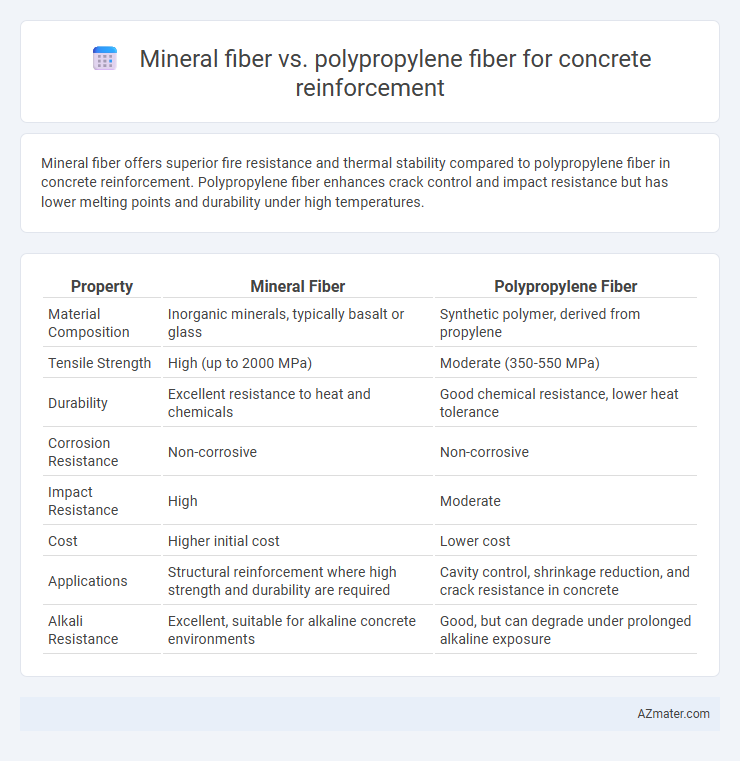Mineral fiber offers superior fire resistance and thermal stability compared to polypropylene fiber in concrete reinforcement. Polypropylene fiber enhances crack control and impact resistance but has lower melting points and durability under high temperatures.
Table of Comparison
| Property | Mineral Fiber | Polypropylene Fiber |
|---|---|---|
| Material Composition | Inorganic minerals, typically basalt or glass | Synthetic polymer, derived from propylene |
| Tensile Strength | High (up to 2000 MPa) | Moderate (350-550 MPa) |
| Durability | Excellent resistance to heat and chemicals | Good chemical resistance, lower heat tolerance |
| Corrosion Resistance | Non-corrosive | Non-corrosive |
| Impact Resistance | High | Moderate |
| Cost | Higher initial cost | Lower cost |
| Applications | Structural reinforcement where high strength and durability are required | Cavity control, shrinkage reduction, and crack resistance in concrete |
| Alkali Resistance | Excellent, suitable for alkaline concrete environments | Good, but can degrade under prolonged alkaline exposure |
Introduction to Concrete Fiber Reinforcement
Concrete fiber reinforcement involves embedding fibers such as mineral fibers and polypropylene fibers to enhance concrete's structural performance. Mineral fibers provide superior thermal resistance and crack control due to their high tensile strength and rigidity, making them ideal for fire-resistant and high-temperature applications. Polypropylene fibers offer excellent resistance to shrinkage cracks and improve impact resistance, making them cost-effective solutions for controlling plastic shrinkage in concrete slabs and pavements.
Overview of Mineral Fiber in Concrete
Mineral fiber in concrete reinforcement provides enhanced durability and fire resistance due to its inorganic nature and high melting point. These fibers improve crack control and tensile strength by distributing loads more evenly throughout the concrete matrix. Commonly made from basalt, glass, or slag, mineral fibers offer superior thermal stability compared to polypropylene fibers, making them ideal for high-temperature applications.
Overview of Polypropylene Fiber in Concrete
Polypropylene fiber in concrete enhances durability by improving crack resistance and impact strength, with fibers typically measuring 12-19 mm in length and a tensile strength of 350-550 MPa. Its hydrophobic nature reduces water absorption, minimizing shrinkage and increasing freeze-thaw resistance, making it ideal for slabs, pavements, and precast elements. Compared to mineral fiber, polypropylene offers better chemical resistance and flexibility, effectively controlling plastic shrinkage cracks in various environmental conditions.
Mechanical Properties Comparison
Mineral fibers exhibit higher tensile strength and modulus of elasticity compared to polypropylene fibers, enhancing concrete's load-bearing capacity and crack resistance. Polypropylene fibers offer superior impact resistance and flexibility, improving concrete toughness and reducing shrinkage cracks but providing lower stiffness. The choice depends on required mechanical performance: mineral fibers for rigidity and strength, polypropylene fibers for ductility and crack control.
Durability and Longevity
Mineral fibers such as basalt or glass offer enhanced chemical and heat resistance, making them highly durable for concrete reinforcement in harsh environments. Polypropylene fibers provide excellent resistance to corrosion and alkali attacks, ensuring long-term stability, but may have lower tensile strength compared to mineral fibers. Both fiber types improve crack control and structural longevity, with mineral fibers often preferred for higher durability applications requiring thermal and chemical resilience.
Impact on Concrete Workability
Mineral fibers, such as basalt or glass fibers, slightly reduce concrete workability due to their stiffness and tendency to cause fiber clumping, necessitating adjustments in water or admixture usage. Polypropylene fibers improve plastic concrete workability by enhancing cohesiveness and reducing bleeding, thanks to their lightweight and hydrophobic properties. Both fiber types affect mix design, but polypropylene fibers generally allow for easier slump retention and finishing in concrete applications.
Resistance to Cracking and Shrinkage
Mineral fiber provides superior resistance to cracking and shrinkage due to its high tensile strength and thermal stability, effectively distributing stress within concrete matrices. Polypropylene fiber enhances crack control by reducing plastic shrinkage and improving impact resistance, though it exhibits lower tensile performance compared to mineral fibers. The choice between mineral and polypropylene fibers depends on specific structural requirements, with mineral fibers favored for high-strength applications demanding enhanced durability.
Cost and Availability
Mineral fiber offers moderate cost and widespread availability, making it a reliable choice for concrete reinforcement in many construction projects. Polypropylene fiber is generally more affordable and widely accessible, especially in regions with established plastic manufacturing industries. Cost-effectiveness and local supply chains often determine the preference between these fibers in concrete applications.
Environmental Considerations
Mineral fiber and polypropylene fiber offer distinct environmental profiles in concrete reinforcement. Mineral fibers, often derived from natural or recycled raw materials like basalt or glass, provide enhanced durability and fire resistance with minimal carbon footprint, promoting sustainability. Polypropylene fibers, while lightweight and corrosion-resistant, are synthetic polymers derived from petroleum, raising concerns about fossil fuel dependency and microplastic pollution during degradation.
Applications and Best Use Cases
Mineral fibers, such as basalt and glass fibers, excel in high-temperature and fire-resistant concrete applications, making them ideal for industrial floors, tunnels, and refractory structures. Polypropylene fibers provide excellent crack control and impact resistance in general-purpose concrete, commonly used in residential slabs, pavements, and precast elements. For structural elements requiring durability and chemical resistance, mineral fibers outperform polypropylene fibers, which are better suited for shrinkage control and secondary reinforcement.

Infographic: Mineral fiber vs Polypropylene fiber for Concrete reinforcement
 azmater.com
azmater.com